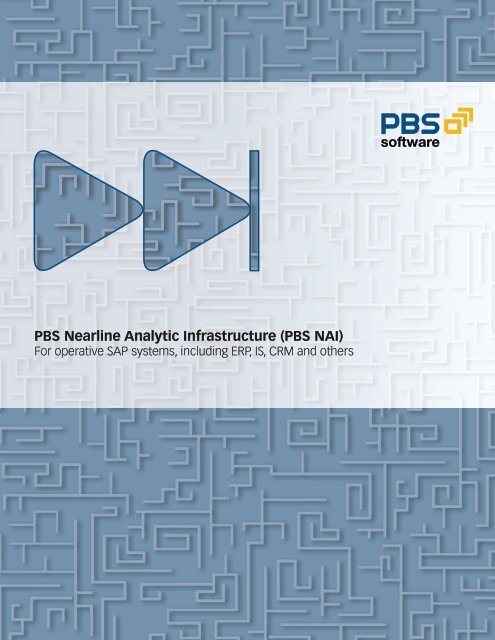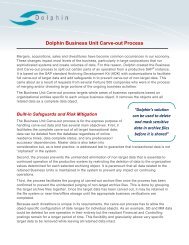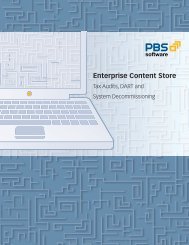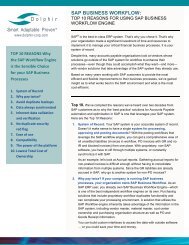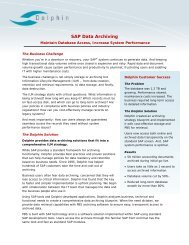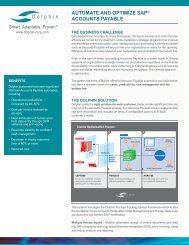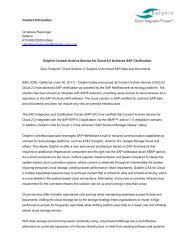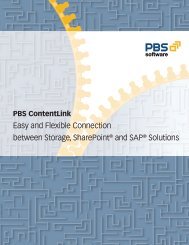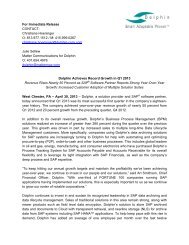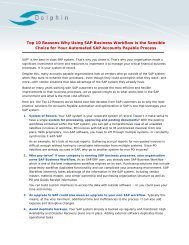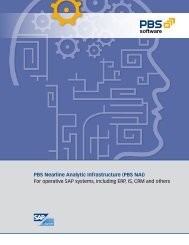PBS Nearline Analytic Infrastructure (PBS NAI) - PBS Software
PBS Nearline Analytic Infrastructure (PBS NAI) - PBS Software
PBS Nearline Analytic Infrastructure (PBS NAI) - PBS Software
You also want an ePaper? Increase the reach of your titles
YUMPU automatically turns print PDFs into web optimized ePapers that Google loves.
Table of Contents<strong>PBS</strong> ContentLink –<strong>PBS</strong> Efficient <strong>NAI</strong> <strong>Nearline</strong> Usage of <strong>Analytic</strong> Modern <strong>Infrastructure</strong> Storage Systems (Version as 1.0) an Archive ............3Introduction Direct Compliant .................................................................................................3Usage of SAP ECM functionality .........................4Architecture Cost Savings and and Components Increase in ..................................................................4Performance ....................................6DataFlexibleRetrievalRetrievalwith <strong>NAI</strong>..............................................................................7Replication ...........................................................5Administration of <strong>NAI</strong> Processes: The <strong>NAI</strong> Monitor ..................................6Information Lifecycle Management –Access the Interaction to Archived makes Data: the <strong>NAI</strong>-AS Difference – the Extended ..............................................8SAP AS .......................6Analyzing Special <strong>PBS</strong> SAP ContentLink Application Data Features with <strong>NAI</strong> ...................................................9Queries ...................................7Evaluation Implementation of Data Scenarios Extracts with – the <strong>NAI</strong> DART Viewer .............................8Embedding in the SAP <strong>Infrastructure</strong> ............................................10Integration of <strong>PBS</strong> archive add ons: <strong>NAI</strong>-compatible <strong>PBS</strong> Modules .........9System Requirements ....................................................................11Lowering the TCO .....................................................................................10Supported Company SAP Profile Systems .............................................................................12and Platforms, <strong>PBS</strong> Licensing ..........................112
4Architecture and ComponentsTable of Contents<strong>PBS</strong> <strong>NAI</strong> is a software package that enablesto use the column-based Sybase IQ asTake a close look at the architectureof the <strong>PBS</strong> <strong>Nearline</strong> <strong>Analytic</strong> Infra-nearline database within an operative SAP structure and you will see all theenvironment. <strong>PBS</strong> ContentLink SAP acts – as the leading system.Efficient Thanks to Usage its high of maturity Modern level Storage and Systems the solution: as an Archive ............3software components that make uplarge amount of productive installations, • <strong>NAI</strong> Database Sybase IQ for highlyDirect Compliant Usage of SAP ECM functionality .........................4Sybase IQ offers a high degree of stability compressed and column-basedArchitecture and scalability. With and the Components<strong>PBS</strong> <strong>NAI</strong> interface, Take data a close storage look and at the analysis architecture of theCost Savings and Increase in Performance<strong>PBS</strong>....................................6<strong>Nearline</strong> <strong>Analytic</strong> <strong>Infrastructure</strong> and youapplication data from an SAP system can • <strong>NAI</strong> Interface for creating connecwillsee all the software components thatbe transferred Flexible Retrieval to the <strong>NAI</strong> ..............................................................................7database and make tions up between the solution: the SAP system and<strong>PBS</strong> <strong>NAI</strong> is a software package that allows for a columnbasedserver to be directly used as part of operative SAP <strong>PBS</strong> <strong>Nearline</strong> <strong>Analytic</strong> <strong>Infrastructure</strong> and youTake a close look the architecture of thedata can be analyzed directly in SAP using • <strong>NAI</strong> the Database <strong>NAI</strong> database Sybase IQ for highly com-systems. the Here, Information analytics SAP acts server. as Lifecycle the lead system. Management The columnbasedanalytics server Sybase IQ is used as the <strong>NAI</strong> data-make analysis up the solution:– will • <strong>NAI</strong> see all Archive the software Information components that System asbase. Thanks the to Interaction its high maturity makes level and large the number Difference of ..............................................8an extension of SAP AS for storing• <strong>NAI</strong> • <strong>NAI</strong> Database Interface Sybase for IQ creating for highly connections compressedbet-installations, it offers a high degree of stability and scalability.With the <strong>PBS</strong> <strong>NAI</strong> interface, application data from an analysisthe indexesand column-basedon thedata<strong>NAI</strong>storagedatabaseandSAP system Special can be transferred <strong>PBS</strong> ContentLink to the <strong>NAI</strong> database Features and ...................................................9• <strong>NAI</strong><strong>NAI</strong>InterfaceReplicationfor creatingforconnectionstransferringbetweenthe SAP system and the <strong>NAI</strong> databasedata can be analyzed directly in SAP using the analyticsserver.data from an SAP database or an<strong>NAI</strong> databaseImplementation Scenarios –• <strong>NAI</strong> Archive Information System as an extensionSAP of SAP archive AS for storing the indexes on theEmbedding in the SAP <strong>Infrastructure</strong> ............................................10<strong>NAI</strong>• SAPdatabase<strong>NAI</strong> database Queries for an analyzing SAP archive SAP data<strong>PBS</strong> <strong>NAI</strong>• <strong>NAI</strong> Replication for transferring data from an<strong>Nearline</strong> <strong>Analytic</strong> System <strong>Infrastructure</strong> <strong>NAI</strong> DatabaseRequirements ....................................................................11SAP • <strong>NAI</strong> database Queries DART or Viewer for an SAP analyzing archive for quick SAP data evalu-<strong>NAI</strong>-AS <strong>PBS</strong> <strong>NAI</strong>Sybase IQ<strong>Nearline</strong> <strong>Analytic</strong> <strong>Infrastructure</strong> <strong>NAI</strong> Database • <strong>NAI</strong> ation Queries of for data analyzing extracts SAP data from the<strong>NAI</strong> Archive Information System Column-based<strong>NAI</strong>-ASSybase IQextracts from the SAP Data Retention Tool<strong>NAI</strong>-R Company Profile .............................................................................12<strong>Analytic</strong>s Server • <strong>NAI</strong> DART Viewer for quick evaluation of data<strong>NAI</strong> Archive Information System Column-based SAP Data Retention Toolextracts from the SAP Data Retention Tool<strong>NAI</strong> Replication• <strong>NAI</strong> Monitor for administration of the <strong>NAI</strong><strong>NAI</strong>-R<strong>Analytic</strong>s Server<strong>NAI</strong> Interface<strong>NAI</strong> Monitor for administration of<strong>NAI</strong>-Q <strong>NAI</strong> Replication• <strong>NAI</strong> solution Monitor for administration of the <strong>NAI</strong><strong>NAI</strong> Interface<strong>NAI</strong> Query <strong>NAI</strong>-Qsolutionthe <strong>NAI</strong> solutionArchitecture and Components<strong>PBS</strong> <strong>NAI</strong> is a software package that allows for a columnbasedserver to be directly used as part of operative SAPsystems. Here, SAP acts as the lead system. The columnbasedanalytics server Sybase IQ is used as the <strong>NAI</strong> database.Thanks to its high maturity level and large number ofinstallations, it offers a high degree of stability and scalability.With the <strong>PBS</strong> <strong>NAI</strong> interface, application data from anSAP system can be transferred to the <strong>NAI</strong> database anddata can be analyzed directly in SAP using the analyticsserver.OperativeSAP SystemOperativeSAP SystemSAP ERP,SAP ISU, SAP ERP,SAP CRM, SAP ISU,etc.SAP CRM,etc.<strong>NAI</strong> Query<strong>NAI</strong>-M<strong>NAI</strong>-M<strong>NAI</strong> Monitor <strong>NAI</strong> Monitor<strong>NAI</strong>-DART <strong>NAI</strong>-DART<strong>NAI</strong> DART <strong>NAI</strong> Viewer DART Viewerpressed and column-based data storage andween the SAP system and the <strong>NAI</strong> database• <strong>NAI</strong> Archive Information System as an extensionof SAP AS for storing the indexes on the• <strong>NAI</strong> Replication for transferring data from an• <strong>NAI</strong> DART Viewer for quick evaluation of dataFigure 1:Figure 1: Figure <strong>PBS</strong> 1: <strong>Nearline</strong> <strong>Analytic</strong> <strong>Infrastructure</strong> Architecture<strong>PBS</strong> <strong>Nearline</strong> <strong>Analytic</strong> <strong>Infrastructure</strong> Architecture<strong>PBS</strong> <strong>Nearline</strong> <strong>Analytic</strong> <strong>Infrastructure</strong> Architecture24<strong>NAI</strong>-AS for FI:<strong>PBS</strong> offers a template for the Financial Accounting that al-<strong>NAI</strong>-AS for FI:lows <strong>NAI</strong>-AS standard SAP for users FI: <strong>PBS</strong> to make offers use a of template the <strong>NAI</strong> Archive for<strong>PBS</strong> offers a template for the Financial Accounting that allowsstandard the Financial Accounting that allows stan-Information System. This FI template allows for standardarchiving SAP processes users to to make be optimized use of for the SAP <strong>NAI</strong> financial Archive accounting.System. dard SAP This users FI template to make allows use for of the standard <strong>NAI</strong>Informationarchiving processes to be optimized for SAP financial accounting.Archive Information System. This FI templateallows to optimize standard archivingprocesses.Figure 2:The Figure area menu 2: The for area <strong>NAI</strong> menu for <strong>NAI</strong><strong>NAI</strong>-AS forFigure 2:FI: <strong>PBS</strong> offers a template for the FinancialThe area menu for <strong>NAI</strong>Accounting that al-lows standard SAPusers to make use of the <strong>NAI</strong> Archive InformationSystem. This FI template allowsfor standard archiving processes to beoptimized for SAP financial ac-counting.
Data Retrieval with <strong>NAI</strong> ReplicationData Retrieval with <strong>NAI</strong> ReplicationData Retrieval with <strong>NAI</strong> ReplicationWhen the connection is made between the <strong>NAI</strong> databaseWhen the connection is made between the <strong>NAI</strong> database and an SAP system, dataand is transferred an SAP system, between data the is SAP transferred database between and / or the SAP SAP archive and <strong>NAI</strong> databasedatabase through When the an and/or connection <strong>NAI</strong> process. SAP is archive made between and <strong>NAI</strong> the database <strong>NAI</strong> database through and an an SAP system, data<strong>NAI</strong> is transferred process. between the SAP database and / or SAP archive and <strong>NAI</strong> databaseTo through facilitate an <strong>NAI</strong> the process. transfer of data, <strong>PBS</strong> offers <strong>NAI</strong> replication that features thefollowing functionalities:To facilitate the data transfer, <strong>PBS</strong> offers <strong>NAI</strong> replicationthat features the following functionalities:• To Creation facilitate of the <strong>NAI</strong> transfer tables on of the data, <strong>NAI</strong> <strong>PBS</strong> database offers <strong>NAI</strong> replication that features thefollowing functionalities:• Transferring of data from an SAP database or SAP archive to an <strong>NAI</strong> table• Creation of <strong>NAI</strong> tables on the <strong>NAI</strong> database• Deletion Creation of of an <strong>NAI</strong> tables on the <strong>NAI</strong> database• Transferring of data from an SAP database or SAP archive to an <strong>NAI</strong> table• Data transfer from an SAP database• Deletion of an <strong>NAI</strong> tableor SAP archive to an <strong>NAI</strong> table• Deletion of an <strong>NAI</strong> tableOperative SAP systemOperative SAP systemSAPDBSAPDB<strong>NAI</strong>Process<strong>NAI</strong>DB<strong>NAI</strong>DB<strong>NAI</strong>Figure 3:ProcessConnecting an SAP system to an <strong>NAI</strong> database<strong>NAI</strong>Process<strong>NAI</strong>ProcessFigure 3:3: Connecting an SAP system to an <strong>NAI</strong> databaseConnecting an SAP system to an <strong>NAI</strong> databaseSAPArchiveSAPArchiveFigure 4: 4: Transferring data through <strong>NAI</strong> replicationTransferring data through <strong>NAI</strong> replicationFigure Separate 4: application-specific solutions are available for moreTransferring data through <strong>NAI</strong> replicationcomplex data structures from multiple tables.Separate application-specific solutions are available formore complex data structures from multiple tables.Separate application-specific solutions are available for55
Analyzing SAP Application Datawith <strong>NAI</strong> QueriesAnalyzing SAP Application Data with <strong>NAI</strong> QueriesAnalyzing SAP Application Data with <strong>NAI</strong> QueriesWith <strong>NAI</strong> Query, <strong>PBS</strong> offers a tool of its own for performing flexible and fast evaluation of the data stored inside the columnbaseddatabase With Sybase <strong>NAI</strong> Query, IQ. This <strong>PBS</strong> offers allows a for tool <strong>NAI</strong> of its tables own for to be performing evaluated flexible on a and table-related fast evaluation basis. of the data stored inside thecolumn-based database Sybase IQ. This allows for <strong>NAI</strong> tables to be evaluated on a table-related basis.It is incredibly simple to start an <strong>NAI</strong> query:You would like to see the line items that belong to theWith <strong>NAI</strong> Query, <strong>PBS</strong> offers a tool of its own for performing flexible and fast evaluation of the data stored inside the• Choose column-based It is incrediblythe application database simpleand Sybase to starttable IQ. This an <strong>NAI</strong> allows query: for <strong>NAI</strong> tables to be marked You evaluated would lines on like a of table-related to your see report? the line basis. No items problem: that belong just to mark the themarked lines of your report? No problem: just mark theline, select the function key ‘Drill Down‘ and you will be• Determine • Choose the fields the application and grouping and table thatline, select the function key ‘Drill Down‘ and you will beIt is incredibly simple to start an <strong>NAI</strong> query:You provided would like with to a see list the of of line line line items:items: that belong to theare to be • put Determine out the fields and groupingmarked lines of your report? No problem: just mark the• Select • aggregationChoose that the are application to be put out and tableline, select the function key ‘Drill Down‘ and you will beprovided with a list of line items:• Execute • Determine • Select aggregationthe fields and groupingthat are to be put out• ExecuteAn <strong>NAI</strong> query • Select uses aggregation column-based technology to generateAn <strong>NAI</strong> query uses column-based technology to generatesummary reports on large data volumes in a fast and flexiblemanner. ble manner.• Execute summary reports on large data volumes in a fast and flexi-An <strong>NAI</strong> query uses column-based technology to generatesummary You are reports interested on large in data producing volumes a in summary a fast and report flexiblemanner. archived in producing FI documents? a summary This can be report done on in a archi-quick andFigure 8onYou are interestedeasy manner. The result could look as follows:ved FI documents? This can be done in a quick and easyYou are interested in producing a summary report on Other features:manner. The archived result FI could documents? look as This follows: can be done in a quick and Figure Other 8 functions:• You will be able to use the report interface toeasy manner. The result could look as follows:• You will be able to use the report interface to branchbranch off into an off SAP into transaction an SAP transaction from a line item. from a line item.Other functions:•• You will be be able able to create to create an <strong>NAI</strong> an query <strong>NAI</strong> not query only not for only• You individual will be able tables to use or the SAP report DB views, interface but will to branch also beoff into for able individual an to SAP analyze transaction the tables joins from or between SAP a line DB various item. views, tables. but will also• You • be The will able <strong>NAI</strong> be able database to analyze to create is not the an the <strong>NAI</strong> joins only query between data not source only various for you tables.individual will have tables available. or SAP You DB views, can also but perform will also analysis be onable • The data to analyze <strong>NAI</strong> from database the the SAP joins system between is not or the analyze various only a tables. query data for source the you• The will <strong>NAI</strong><strong>NAI</strong>anddatabase have SAP available. database.is not the You only can data also source perform you analysiswill • on have You data will available. also from be You the able can SAP to also use system an perform <strong>NAI</strong> query or analysis analyze to analyze on a querydata key from figures the SAP that system have been or analyze calculated. a query for the<strong>NAI</strong> for and the SAP <strong>NAI</strong> database. and SAP database.• You will be able to define access rights based on authorizations.will also will be also able be to able use an to <strong>NAI</strong> use query an to <strong>NAI</strong> analyze query to• You • Youkey figures that have been calculated.• analyze It will also key be possible figures for that you have to use been an <strong>NAI</strong> calculated.query toFigure 7• You search will be for able line to items define with access certain rights characteristics.based on authorizations.• You will be able to define access rights based onHere, an aggregation of the line items takes place at the • It will With the help of <strong>NAI</strong> queries, summary reports that areauthorizations.also be possible for you to use an <strong>NAI</strong> query tolevel of the general ledger account. Possible aggregations based on many millions of data records can be analyzed inFigure 7 Figure 7search for line items with certain characteristics.include, for instance, formation of summaries, maximum • only It will seconds. also be possible for you to use an <strong>NAI</strong> queryHere, and minimum aggregation amounts. of the line items takes place at the With the help of <strong>NAI</strong> queries, summary reports that areto search for line items with certain characteristics.level of the general ledger account. Possible aggregations based on many millions of data records can be analyzed inHere, an aggregation include, for instance, of the line formation items of takes summaries, place at maximum the only seconds.and minimum amounts.level of the general ledger account. Possible aggregations With the help of <strong>NAI</strong> queries, summary reports that areinclude, for instance, formation of summaries, maximum based on many millions of data records can be analyzed inand minimum amounts.only seconds.777
Evaluation of Data Extracts with the <strong>NAI</strong> DART ViewerEvaluation of of Data Extracts with the <strong>NAI</strong> DART ViewerEvaluation of Data Extracts withthe <strong>NAI</strong> DART ViewerYou are interested in being able to analyze Table data extracts that of have been Contentsproduced using the SAPYou are interested in being able to analyze data extracts that have been produced using the SAPData Retention Tool and leverage the advantages that the column-based <strong>NAI</strong> database offers?You You are are interested in in being being able able to to analyze to analyze data data extracts extracts that that have have been been produced produced using using the SAP the SAP Data Retention ToolYou are interested in being able to analyze data extracts that have been produced using the SAPData and leverage the advantages that the column-based <strong>NAI</strong> database offers?DataData RetentionRetentionRetention ToolToolTool andandand leverageleverageleverage thethethe advantagesadvantagesadvantages thatthatthat thethethe column-basedcolumn-basedcolumn-based <strong>NAI</strong><strong>NAI</strong><strong>NAI</strong> databasedatabasedatabase offers?offers?offers?SAP DARTDART <strong>PBS</strong> ContentLink SAP DART –DARTExtractExtract ViewSAP Efficient Usage of Modern Storage Systems as an Archive ............3SAPSAP DARTDARTDARTDARTSAPSAPSAP DARTDARTDARTDARTDARTDARTDARTDARTExtractExtractExtractExtract ViewExtractExtractViewView Tax AuthorityDirect Compliant Usage of SAP ECM functionality .........................4<strong>NAI</strong> QueryTaxTax <strong>PBS</strong> <strong>NAI</strong>Tax AuthorityAuthorityAuthorityDARTDARTDARTCost Savings and Increase in Performance <strong>NAI</strong><strong>NAI</strong> Query ....................................6<strong>PBS</strong><strong>PBS</strong> Query<strong>NAI</strong><strong>NAI</strong>ExtractExtract <strong>NAI</strong> Query View<strong>PBS</strong> <strong>NAI</strong>DARTDARTDARTDARTDARTDARTDARTDARTDARTFlexible RetrievalExtractExtract ..............................................................................7ExtractExtract Column-based ExtractExtract ViewViewViewFigure 9CompressedColumn-basedColumn-basedColumn-basedFigureFigureFigure 99CompressedInformation CompressedCompressed Lifecycle Management –Proceed as follows:the Interaction makes the Difference ..............................................8Proceed Gain as ProceedProceed as an as asas overview follows: of the data extracts.follows:follows:Special <strong>PBS</strong> ContentLink Features ...................................................9 Gain an GainGain an an anan overviewoverviewoverview of of ofof thethethe datadatadata extracts.extracts.extracts.Implementation Scenarios –Embedding in the SAP <strong>Infrastructure</strong> ............................................10System Requirements ....................................................................11Company Profile .............................................................................12Figure 10Export the extracts into the <strong>NAI</strong> database. Export the <strong>NAI</strong> ExportExport thethethe extractsextractsextracts Figureintointointo the11thethe <strong>NAI</strong><strong>NAI</strong><strong>NAI</strong> database.database.database.Analyze the data with Figure the FigureFigure help 11 111111 of <strong>NAI</strong> Query. Analyze Select the data with help of <strong>NAI</strong> Query.AnalyzeAnalyze thethethe the data viewdatadata with ofwithwith the thethethe help data:helphelp of of ofof <strong>NAI</strong><strong>NAI</strong><strong>NAI</strong> Query.Query.Query. Select the SelectSelect thethethe viewviewview of of ofof thethethe data:data:data:FigureFigureFigure 10 101010 10 Analyze data:AnalyzeAnalyzeAnalyze data:data:data:Figure 12Figure FigureFigure 12 1212128 828Figure 13 13FigureFigureFigure 13 131313
Integration of <strong>PBS</strong> archive add ons:Integration <strong>NAI</strong>-compatible <strong>PBS</strong> of <strong>PBS</strong> Modules archive add ons:Integration of <strong>PBS</strong> archive add ons:<strong>NAI</strong>-compatible <strong>PBS</strong> <strong>PBS</strong> Modules ModulesAre you already using <strong>PBS</strong> archive add ons and now interested in using <strong>NAI</strong>?Are you already using <strong>PBS</strong> archive add ons and now interested in using <strong>NAI</strong>?Are you already using <strong>PBS</strong> archive add ons and now interested in using <strong>NAI</strong>?In order to make it possible to use <strong>PBS</strong> archive add ons Drilling down to a line item delivers the following result fortogether with the <strong>Nearline</strong> <strong>Analytic</strong> <strong>Infrastructure</strong>, <strong>PBS</strong> is a specific item:To use <strong>PBS</strong> archive add ons together with the <strong>Nearline</strong> Drilling down to a line item delivers the following result forcommitted to gradually In order to expanding make it possible its range to use of <strong>PBS</strong> software archive add ons Drilling down to a line item delivers the following result for<strong>Analytic</strong> modules <strong>Infrastructure</strong>, to include together <strong>PBS</strong> with <strong>PBS</strong> <strong>NAI</strong>-compatible the is committed <strong>Nearline</strong> <strong>Analytic</strong> modules. to gradually <strong>Infrastructure</strong>, The two <strong>PBS</strong> isa specific item: item:committed to gradually expanding its range of softwareexpanding <strong>PBS</strong> archive its add range ons of CPCA software (Profit modules Center Accounting) to include <strong>PBS</strong> andmodules to include <strong>PBS</strong> <strong>NAI</strong>-compatible modules. The twoCCOPA (Profitability Analysis) are already available. Now,<strong>NAI</strong>-compatible <strong>PBS</strong> modules. archive add The ons two CPCA <strong>PBS</strong> (Profit archive Center add Accounting) ons andarchive data from CCOPA both (Profitability modules Analysis) can also are be already indexed available. and Now,CPCA searched (Profit while Centerarchive using Accounting) <strong>NAI</strong>. data from bothandmodulesCCOPAcan(Profitabilityalso be indexed andAnalysis) are already searched available. while using Now, <strong>NAI</strong>. archive data from bothLet’s take a closer look at an example involving a profitabilityanalysis that shows the link between a <strong>PBS</strong> <strong>NAI</strong>-com-modules can also Let’s be take indexed a closer and look searched at an example while involving using a profitability<strong>NAI</strong>. patible Let’s module take a and closer analysisthe look that<strong>Nearline</strong> shows an <strong>Analytic</strong> example the link between<strong>Infrastructure</strong>.involving a <strong>PBS</strong> a profitabilityBased analysis on a report Based that that shows on a lists report the the link that revenues between lists the revenues from a <strong>PBS</strong> a sales <strong>NAI</strong>-from a sales<strong>NAI</strong>-compatiblemodule and the <strong>Nearline</strong> <strong>Analytic</strong> <strong>Infrastructure</strong>.compatible office, the goal moduleoffice, is now andthe to goalthe branch <strong>Nearline</strong>is now off to<strong>Analytic</strong>branch into the off<strong>Infrastructure</strong>.line into items. the line items.Many of these documents Many of these have documents already have been already archived. been archived. The ThedocumentsBasedhaveon a documents reportbeen indexedthat have lists been onthethe indexed revenues<strong>NAI</strong> on database. the <strong>NAI</strong> from database. a salesoffice, the goal is now to branch off into the line items.Many of these documents have already been archived. Thedocuments have been indexed on the <strong>NAI</strong> database.Figure 15Figure 15Figure 15Nearly all of the line items listed in a report come fromthe archive. Nevertheless, obtaining fast access to theseNearly Nearly all of the line items listed in a report come from theline all items of the is still line not items a problem listed because in a report these come have been fromthe archive. added to Nevertheless, <strong>NAI</strong> database. obtaining This effectively fast fast access relieves to these to these lineline items load onitemsisisstill the operativestillnotnota problem SAP database.a problembecausebecausethesethesehavehavebeenbeen addedOtheradded to the <strong>NAI</strong> database. This effectively relieves theload on theto <strong>NAI</strong>-compatibleoperativethe SAPdatabase. <strong>PBS</strong> archivedatabase.This add effectively ons are currently relieves the loadunder development.on the operative SAP database. Other <strong>NAI</strong>-compatible <strong>PBS</strong>Other archive <strong>NAI</strong>-compatible add ons <strong>PBS</strong> are currently archive add under ons development.are currentlyunder development.Figure 149Figure 1499
Lowering the TCOLowering the TCOCompanies can use the <strong>PBS</strong> <strong>Nearline</strong> <strong>Analytic</strong> <strong>Infrastructure</strong>to lower the TCO of operative SAP applicationTable of Contentssystems (like ERP, IS, CRM, or other) rather considerably:in comparison to all other known techniques, <strong>PBS</strong> ContentLink <strong>NAI</strong> is capableEfficient Usage of Modern Storage Systems as an Archive ............3–Companies can use the <strong>PBS</strong> <strong>Nearline</strong> <strong>Analytic</strong> <strong>Infrastructure</strong>tooflowersignificantlythe TCOreducingof an operativethe indexingSAPruntimesapplicationforarchive system (ERP, data. IS, This CRM, saves or other) valuable rather time considerably: during the in batch comparisonto Because all other the known archive techniques, indexes are <strong>NAI</strong> stored is capable inside ofDirect Compliant Usage of SAP ECM functionality .........................4window.significantly reducing the indexing runtimes for archivethe <strong>NAI</strong> server in a compressed form, this saves diskdata. This saves valuable time during the Cost batch Savings window. and Increase in Performance ....................................6space Because and, the at archive the same indexes time, are relieves stored the inside load the on <strong>NAI</strong> the serverin database. a compressed <strong>NAI</strong> archive form, indexes this saves from diskSAP Flexible the space production and, atRetrieval ..............................................................................7the same time, relieves the load on the SAP database. <strong>NAI</strong>system can be read directly by multiple mirror systems.archive indexes from the production system can be readAccordingly, directly by multiple this multiplies mirror systems. the savings Accordingly, Information effect. Much this multipliesthe response savings times effect. with Much respect faster to response index the Interaction access times with to makes the Difference ..............................................8Lifecycle Management –fasterrespect to index access to archive data represents yetarchive data represents yet another improvement thatanother improvement that leads to an increase in userleads to an increase in user satisfaction. Special <strong>PBS</strong> ContentLink Features ...................................................9satisfaction.<strong>NAI</strong>-AS for FI:Implementation Scenarios –<strong>NAI</strong>-AS for FI: The following table that <strong>PBS</strong> provides forThe following table that <strong>PBS</strong> provides for Embedding use financialthe SAP <strong>Infrastructure</strong> ............................................10use accounting in financial illustrates accounting how noticeably illustrates the how SAP noticeably database the isSAP relieved. database is relieved.System Requirements ....................................................................11SAP Standard<strong>PBS</strong> <strong>NAI</strong>Account Indexes (BSIS Company etc.) Profile .............................................................................12SAP AS1 GB 500 MB<strong>NAI</strong>-AS for FI (FI Template)300 MBSavings 80%Figure 16 16This table illustrates the storage requirements that pertainto the to database the database of an of SAP an SAP system system in comparison in comparison to the toThis table illustrates the storage requirements that pertainthe storage storage requirement when when the <strong>PBS</strong> the <strong>Nearline</strong> <strong>PBS</strong> <strong>Nearline</strong> <strong>Analytic</strong> <strong>Analytic</strong> <strong>Infrastructure</strong>is used. Altogether, the account indexes on customers,vendors and G/L accounts as well as the Archive<strong>Infrastructure</strong> is used. Altogether, the account indexeson Information customers, System vendors SAP and AS require G/L accounts disk space as well of 1.5 as the GB.Archive Utilization Information of the FI Template System with SAP AS the require Archive disk Information spaceofSystem1.5 GB.<strong>NAI</strong>-ASUtilizationreducesofthe amountFI Templateof requiredwith thediskArchivespaceto 300 MB and thus saves 80% of the storage space.Information System <strong>NAI</strong>-AS reduces the amount of requireddisk space to 300 MB and thus saves 80% of thestorage space.210
Supported SAP Systems andPlatforms, <strong>PBS</strong> Licensing¹In principle, the <strong>PBS</strong> <strong>Nearline</strong> <strong>Analytic</strong> <strong>Infrastructure</strong> can beused together with all operative SAP systems (ERP, CRM,ISU among others) starting with Release 4.7.The <strong>PBS</strong> <strong>Nearline</strong> <strong>Analytic</strong> <strong>Infrastructure</strong> runs on operatingsystem platforms like IBM AIX, HP-UX, Linux, Sun Solarisand Microsoft Windows Server².The pricing model for software from <strong>PBS</strong> is based on thenumber of users of the operative SAP application systems(ERP, CRM etc.), the so-called ‘named users’ or the numberof contracts or contract accounts for SAP IS solutions. Weoffer hotline support for <strong>PBS</strong> customers who have a maintenancecontract.<strong>PBS</strong> concentrates mainly on software development. Ourconsulting partners will be more than happy to offer youconsulting and project management services.Once you have purchased our <strong>PBS</strong> <strong>Nearline</strong> <strong>Analytic</strong><strong>Infrastructure</strong> with Sybase IQ we will give you the contactdetails of a qualified person who can help you withthe complete solution. This means that <strong>PBS</strong> support willbe happy to assist you even if you have questions on theSybase IQ Server.<strong>PBS</strong> solutions can be purchased directly from <strong>PBS</strong> or froman appropriate authorized partner. To obtain further informationand a complete list of partners, please check the‘Buy‘ section of our website.¹ <strong>NAI</strong>-compatible <strong>PBS</strong> modules are not included in an<strong>NAI</strong> license.² <strong>PBS</strong> <strong>NAI</strong> can be operated in parallel on one shared analytics servertogether with the <strong>PBS</strong> <strong>Nearline</strong> Storage Solutions for SAP NetWeaverBusiness Warehouse.11


